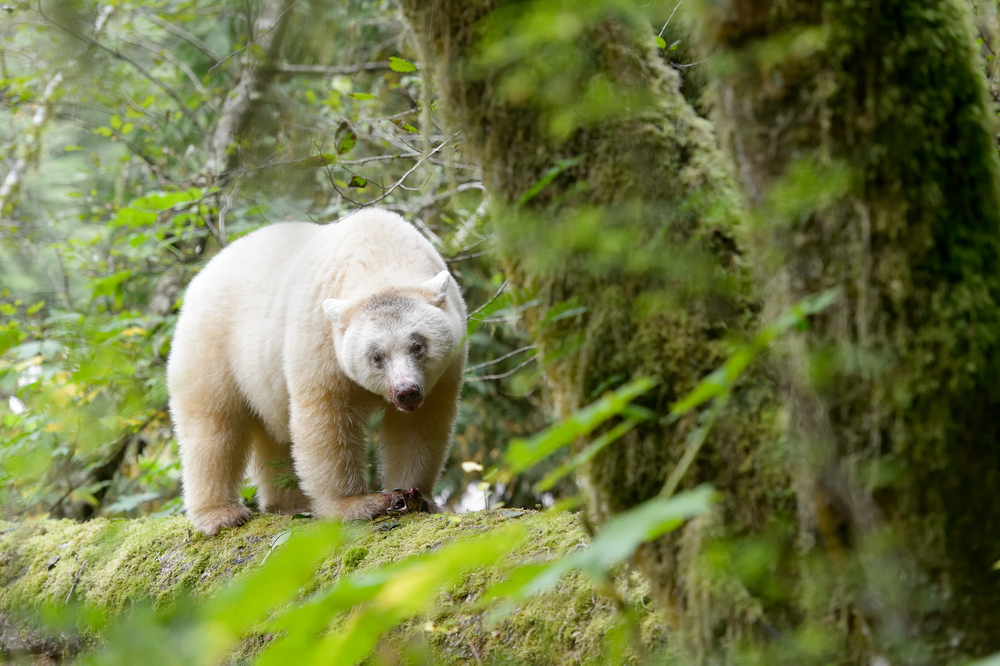
Starting in the vast, roadless, volcano-pockmarked Katmai National Park and Preserve in southwest Alaska, where earthquakes happen on a daily basis and gigantic grizzlies roam around at the very apex of the food chain, the stunning new film The Search for Ghost Bears takes viewers on a jaw-dropping journey to the cloud forests of British Columbia in pursuit of a meeting with the mysterious and rare ghost bears that haunt the region.
En route, this epic cinematic bear hunt also goes looking for black bears, which are relatively common throughout North America, from Alaska down to the Sierra Madre in Mexico, and enjoys an encounter with the elusive and little understood glacier bear.
The common denominator between all of these big teddies is an obsession for salmon and a need to chubby up ahead of their long winter sleep. Accordingly, the extraordinary life cycle that salmon put themselves through provides the thread that runs right through the film, as the fish make their tortuous way upstream from the sea to their spawning grounds, dragged in by bizarre innate urges that force them to battle rapids and each other (let alone brave the paws and jaws of the bears, bald eagles, sea otters and other predators lying in wait for them) before mating and then promptly dying.
It’s a strange life being a sockeye salmon, and it doesn’t end well for many of them, who get chomped well before they get a chance to mate, but they move in such large numbers that scientists refer to the migration as a ‘red flood’. The bears certainly don’t complain about over supply, and in Katmai’s Hallo Bay, viewers are treated to some super scenes of baby brown bear cubs being taught how to handle their first fish, as well as funny footage of rusty adults who still haven’t mastered the art, floundering around in the shallows trying to sate their titanic 20-fish-a-day appetite.
There are an estimated 2000 brown bears in Katmai, but when the crew decamp to higher ground to search for the phantom known as the glacier bear, their targets are a little tougher to locate. These beautiful bears, with a coat that shines with a silvery blue hue, are a subspecies of the black bear, thought to have evolved during the last ice age.

A study by the Alaska Department of Fish and Game revealed that there are fewer than 100 glacier bears left, so serendipity has to be seriously on your side in order to spot one. Well, that and a good dash of millennia-old local know-how. A Native American ranger suggests the film crew start searching up high, ‘where the winter makes room for the summer’, and there they duly discover their bear, living right alongside one of his black-coated cousins.
On Princess Royal Island off the coast of British Columbia, in the heart of Great Bear Rainforest, they go searching for an even-more elusive encounter with a white bear that is so rare that western science didn’t know it existed until relatively recently. First Nation people knew all about it, though, and the ghost bear, also known as the spirit bear, appears in the traditional stories of the Tsimshiam as a very special figure. According to Tsimshiam legend, one in ten bears was created white, to remind man of a time when the land was covered by ice.
Now that western science has caught up with these amazing animals—which are officially known as the Kermode bear, named after the zoologist Francis Kermode, who studied them around 1900—it argues that colour difference between black bears and ghost bears is simply down to genetics (technically speaking, a unique double recessive gene required is by both parents in order to produce a white bear).

In every other aspect bar their coat, ghost bears are identical to black bears, except the film reveals a new scientific theory claiming that they might be more successful hunters, because the fish can’t see them as easily through the charging white water of the rapids.
The narrator also points at that, with around 500 ghost bears living in the rain forests of British Columbia, that means roughly one in 10 bears is born white… So, in other words, the First Nation Tsimshiam people were right after all.

